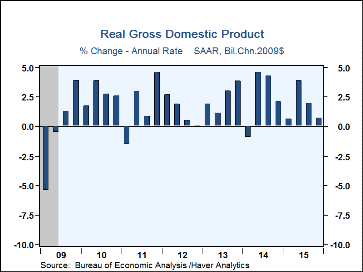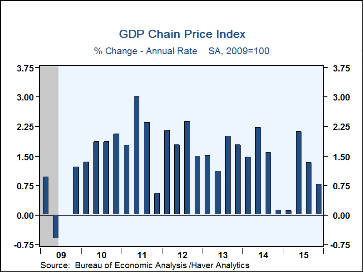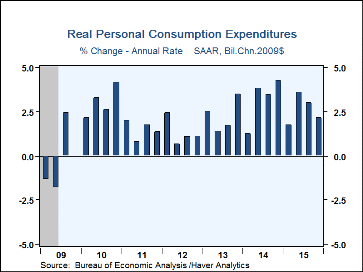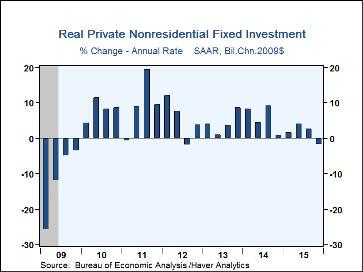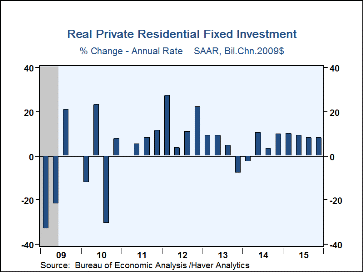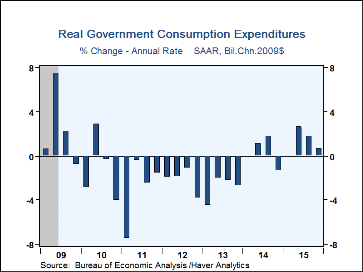 Global| Jan 29 2016
Global| Jan 29 2016U.S. GDP Growth Moderates; Slowdown Is Broad-Based
by:Tom Moeller
|in:Economy in Brief
Summary
Overall economic growth eased during Q4 to 0.7% (AR, 1.8% y/y) versus 2.0% growth in Q3. It was the weakest gain since Q1 of last year. A 0.8% rise had been expected in the Action Economics Forecast Survey. Slower growth was realized [...]
Overall economic growth eased during Q4 to 0.7% (AR, 1.8% y/y) versus 2.0% growth in Q3. It was the weakest gain since Q1 of last year. A 0.8% rise had been expected in the Action Economics Forecast Survey. Slower growth was realized in most sectors while inventories and the foreign trade sector had negative effects. The GDP price index moved up 0.8% (1.1% y/y) after a 1.3% rise. A 0.9% gain had been expected and was the weakest increase since Q1.
Domestic final demand growth softened to 1.6% (2.5% y/y), the weakest increase since Q3'13. Personal consumption expenditures growth eased to 2.2% (2.6% y/y) as growth in spending on nondurable goods fell to 1.5% (2.6% y/y) from 4.2%. Spending on food & beverages fell 1.7% (+0.1% y/y), though it has been weak for two years. Gasoline spending eased 0.3% (+2.5% y/y) but apparel spending improved to 1.7%. The full-year rise of 3.3% was the strongest since 2011. Durable goods spending also slowed to 4.3% (5.2% y/y) from 6.6%. Motor vehicles purchases declined 4.9% (+0.9% y/y) following two quarters of firm increase. Home furnishings eased to 5.5% growth (6.0% y/y), but it has been strong for roughly six years. Recreational goods & vehicle purchases accelerated to 11.9% (9.2% y/y, the fastest growth in five quarters. Services spending was steady at 2.0% (2.2% y/y) as an accelerated 5.7% rise (1.5% y/y) in recreation offset a 1.4% decline (+0.5% y/y) in spending on housing & utilities. Health care spending was stable at 3.8% (3.7% y/y).
Business fixed investment declined at a 1.8% rate (+1.6% y/y), the first decline since Q3'12. A 5.2% falloff (-3.6% y/y) in structures spending was the fifth quarterly decline since early 2014. Equipment investment was off 2.5% (+2.4% y/y), but that was the first decline in a year. Computers & peripheral equipment purchases declined 21.8% (-1.3% y/y) and transportation equipment spending fell 14.0% (+2.3% y/y). These declines were countered by a 7.7% rise (5.8% y/y) in industrial equipment investment. Intellectual property product investment increased 1.6% (4.1% y/y), though growth has slowed sharply compared to the earlier four years. Residential spending increased a steady 8.2% (9.0% y/y).
Government purchases advanced 0.7% (1.3% y/y), the slowest growth since Q1. State & local spending eased 0.6% (+1.4% y/y) following two quarters of strength. Federal defense purchases jumped 3.6% (0.9% y/y) following several years of softness. Nondefense spending increased 1.4%, lifting y/y growth to 1.2%, its strongest in five years.
The foreign trade sector subtracted 0.5 percentage points from GDP growth following a 0.3% Q3 subtraction. These declines caused the full year contribution to GDP growth to be negative for a second year. Exports fell 2.5% (-0.8% y/y) while imports gained 1.1% (3.4% y/y). Inventory investment also was a drag on GDP growth. Its 0.4% negative contribution followed a 0.7 point drag in Q3.
The 0.8% increase (1.1% y/y) in the GDP price index was the weakest since Q1 as energy prices fell. The PCE price index was little changed (0.4% y/y), but excluding food & energy it rose 1.2% (1.4% y/y), the weakest gain since Q1. The business fixed investment price index edged 0.5% higher (0.1% y/y) and the government price index remained unchanged (0.1% y/y). The export price index declined 5.4% (-5.0% y/y) and the import price index fell 7.9% (-8.4% y/y).
The GDP figures can be found in Haver's USECON and USNA database. USNA contains virtually all of the Bureau of Economic Analysis' detail in the national accounts, including the integrated economic accounts and the recently added GDP data for U.S. Territories. The Action Economics consensus estimates can be found in AS1REPNA.
| Chained 2009 $ (%, AR) | Q4'15 (Advance Estimate) | Q3'15 | Q2'15 | Q4 Y/Y | 2015 | 2014 | 2013 |
|---|---|---|---|---|---|---|---|
| Gross Domestic Product | 0.7 | 2.0 | 3.9 | 1.8 | 2.4 | 2.4 | 1.5 |
| Inventory Effect | -0.4 | -0.7 | 0.0 | -0.1 | 0.2 | 0.0 | 0.1 |
| Final Sales | 1.1 | 2.7 | 3.9 | 1.9 | 2.2 | 2.4 | 1.4 |
| Foreign Trade Effect | -0.5 | -0.3 | 0.2 | -0.7 | -0.6 | -0.1 | 0.2 |
| Domestic Final Sales | 1.6 | 2.9 | 3.7 | 2.5 | 2.8 | 2.8 | 1.2 |
| Demand Components | |||||||
| Personal Consumption Expenditures | 2.2 | 3.0 | 3.6 | 2.6 | 3.1 | 2.7 | 1.7 |
| Business Fixed Investment | -1.8 | 2.6 | 4.1 | 1.6 | 2.9 | 6.2 | 3.0 |
| Residential Investment | 8.2 | 8.2 | 9.4 | 9.0 | 8.7 | 1.8 | 9.5 |
| Government Spending | 0.7 | 1.8 | 2.6 | 1.3 | 0.8 | -0.6 | -2.9 |
| Chain-Type Price Index | |||||||
| GDP | 0.8 | 1.3 | 2.1 | 1.1 | 1.0 | 1.6 | 1.6 |
| Personal Consumption Expenditures | 0.1 | 1.3 | 2.2 | 0.4 | 0.3 | 1.4 | 1.4 |
| Less Food/Energy | 1.2 | 1.4 | 1.9 | 1.4 | 1.3 | 1.5 | 1.5 |
Tom Moeller
AuthorMore in Author Profile »Prior to joining Haver Analytics in 2000, Mr. Moeller worked as the Economist at Chancellor Capital Management from 1985 to 1999. There, he developed comprehensive economic forecasts and interpreted economic data for equity and fixed income portfolio managers. Also at Chancellor, Mr. Moeller worked as an equity analyst and was responsible for researching and rating companies in the economically sensitive automobile and housing industries for investment in Chancellor’s equity portfolio. Prior to joining Chancellor, Mr. Moeller was an Economist at Citibank from 1979 to 1984. He also analyzed pricing behavior in the metals industry for the Council on Wage and Price Stability in Washington, D.C. In 1999, Mr. Moeller received the award for most accurate forecast from the Forecasters' Club of New York. From 1990 to 1992 he was President of the New York Association for Business Economists. Mr. Moeller earned an M.B.A. in Finance from Fordham University, where he graduated in 1987. He holds a Bachelor of Arts in Economics from George Washington University.


